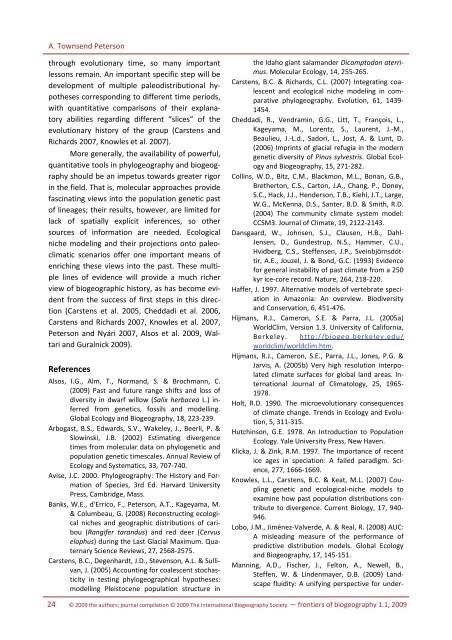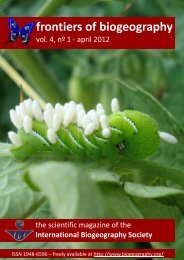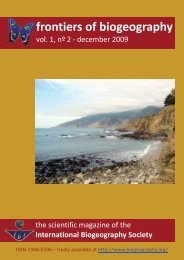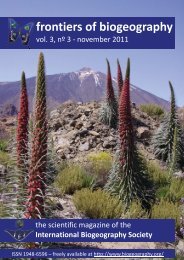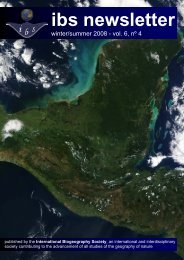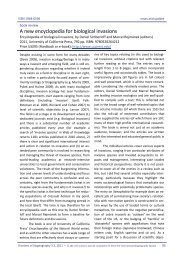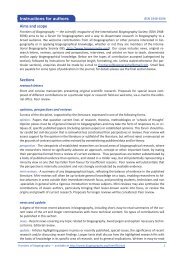entire PDF (2.6 MB) - The International Biogeography Society
entire PDF (2.6 MB) - The International Biogeography Society
entire PDF (2.6 MB) - The International Biogeography Society
- No tags were found...
You also want an ePaper? Increase the reach of your titles
YUMPU automatically turns print PDFs into web optimized ePapers that Google loves.
A. Townsend Peterson<br />
through evolutionary time, so many important<br />
lessons remain. An important specific step will be<br />
development of multiple paleodistributional hypotheses<br />
corresponding to different time periods,<br />
with quantitative comparisons of their explanatory<br />
abilities regarding different “slices” of the<br />
evolutionary history of the group (Carstens and<br />
Richards 2007, Knowles et al. 2007).<br />
More generally, the availability of powerful,<br />
quantitative tools in phylogeography and biogeography<br />
should be an impetus towards greater rigor<br />
in the field. That is, molecular approaches provide<br />
fascinating views into the population genetic past<br />
of lineages; their results, however, are limited for<br />
lack of spatially explicit inferences, so other<br />
sources of information are needed. Ecological<br />
niche modeling and their projections onto paleoclimatic<br />
scenarios offer one important means of<br />
enriching these views into the past. <strong>The</strong>se multiple<br />
lines of evidence will provide a much richer<br />
view of biogeographic history, as has become evident<br />
from the success of first steps in this direction<br />
(Carstens et al. 2005, Cheddadi et al. 2006,<br />
Carstens and Richards 2007, Knowles et al. 2007,<br />
Peterson and Nyári 2007, Alsos et al. 2009, Waltari<br />
and Guralnick 2009).<br />
References<br />
Alsos, I.G., Alm, T., Normand, S. & Brochmann, C.<br />
(2009) Past and future range shifts and loss of<br />
diversity in dwarf willow (Salix herbacea L.) inferred<br />
from genetics, fossils and modelling.<br />
Global Ecology and <strong>Biogeography</strong>, 18, 223-239.<br />
Arbogast, B.S., Edwards, S.V., Wakeley, J., Beerli, P. &<br />
Slowinski, J.B. (2002) Estimating divergence<br />
times from molecular data on phylogenetic and<br />
population genetic timescales. Annual Review of<br />
Ecology and Systematics, 33, 707-740.<br />
Avise, J.C. 2000. Phylogeography: <strong>The</strong> History and Formation<br />
of Species, 3rd Ed. Harvard University<br />
Press, Cambridge, Mass.<br />
Banks, W.E., d'Errico, F., Peterson, A.T., Kageyama, M.<br />
& Columbeau, G. (2008) Reconstructing ecological<br />
niches and geographic distributions of caribou<br />
(Rangifer tarandus) and red deer (Cervus<br />
elaphus) during the Last Glacial Maximum. Quaternary<br />
Science Reviews, 27, 2568-2575.<br />
Carstens, B.C., Degenhardt, J.D., Stevenson, A.L. & Sullivan,<br />
J. (2005) Accounting for coalescent stochasticity<br />
in testing phylogeographical hypotheses:<br />
modelling Pleistocene population structure in<br />
the Idaho giant salamander Dicamptodon aterrimus.<br />
Molecular Ecology, 14, 255-265.<br />
Carstens, B.C. & Richards, C.L. (2007) Integrating coalescent<br />
and ecological niche modeling in comparative<br />
phylogeography. Evolution, 61, 1439-<br />
1454.<br />
Cheddadi, R., Vendramin, G.G., Litt, T., François, L.,<br />
Kageyama, M., Lorentz, S., Laurent, J.-M.,<br />
Beaulieu, J.-L.d., Sadori, L., Jost, A. & Lunt, D.<br />
(2006) Imprints of glacial refugia in the modern<br />
genetic diversity of Pinus sylvestris. Global Ecology<br />
and <strong>Biogeography</strong>, 15, 271-282.<br />
Collins, W.D., Bitz, C.M., Blackmon, M.L., Bonan, G.B.,<br />
Bretherton, C.S., Carton, J.A., Chang, P., Doney,<br />
S.C., Hack, J.J., Henderson, T.B., Kiehl, J.T., Large,<br />
W.G., McKenna, D.S., Santer, B.D. & Smith, R.D.<br />
(2004) <strong>The</strong> community climate system model:<br />
CCSM3. Journal of Climate, 19, 2122-2143.<br />
Dansgaard, W., Johnsen, S.J., Clausen, H.B., Dahl-<br />
Jensen, D., Gundestrup, N.S., Hammer, C.U.,<br />
Hvidberg, C.S., Steffensen, J.P., Sveinbjörnsdóttir,<br />
A.E., Jouzel, J. & Bond, G.C. (1993) Evidence<br />
for general instability of past climate from a 250<br />
kyr ice-core record. Nature, 264, 218-220.<br />
Haffer, J. 1997. Alternative models of vertebrate speciation<br />
in Amazonia: An overview. Biodiversity<br />
and Conservation, 6, 451-476.<br />
Hijmans, R.J., Cameron, S.E. & Parra, J.L. (2005a)<br />
WorldClim, Version 1.3. University of California,<br />
Berkeley. http://biogeo.berkeley.edu/<br />
worldclim/worldclim.htm.<br />
Hijmans, R.J., Cameron, S.E., Parra, J.L., Jones, P.G. &<br />
Jarvis, A. (2005b) Very high resolution interpolated<br />
climate surfaces for global land areas. <strong>International</strong><br />
Journal of Climatology, 25, 1965-<br />
1978.<br />
Holt, R.D. 1990. <strong>The</strong> microevolutionary consequences<br />
of climate change. Trends in Ecology and Evolution,<br />
5, 311-315.<br />
Hutchinson, G.E. 1978. An Introduction to Population<br />
Ecology. Yale University Press, New Haven.<br />
Klicka, J. & Zink, R.M. 1997. <strong>The</strong> importance of recent<br />
ice ages in speciation: A failed paradigm. Science,<br />
277, 1666-1669.<br />
Knowles, L.L., Carstens, B.C. & Keat, M.L. (2007) Coupling<br />
genetic and ecological-niche models to<br />
examine how past population distributions contribute<br />
to divergence. Current Biology, 17, 940-<br />
946.<br />
Lobo, J.M., Jiménez-Valverde, A. & Real, R. (2008) AUC:<br />
A misleading measure of the performance of<br />
predictive distribution models. Global Ecology<br />
and <strong>Biogeography</strong>, 17, 145-151.<br />
Manning, A.D., Fischer, J., Felton, A., Newell, B.,<br />
Steffen, W. & Lindenmayer, D.B. (2009) Landscape<br />
fluidity: A unifying perspective for under-<br />
24 © 2009 the authors; journal compilation © 2009 <strong>The</strong> <strong>International</strong> <strong>Biogeography</strong> <strong>Society</strong> — frontiers of biogeography 1.1, 2009


